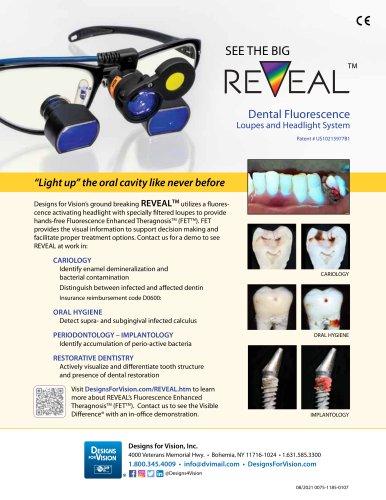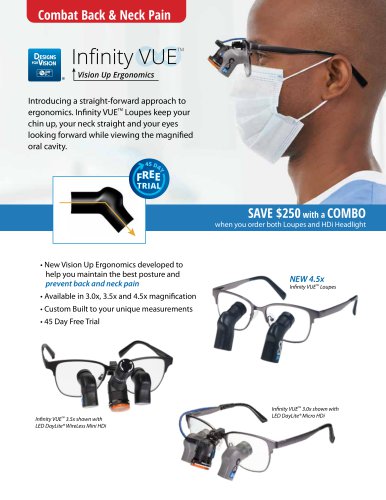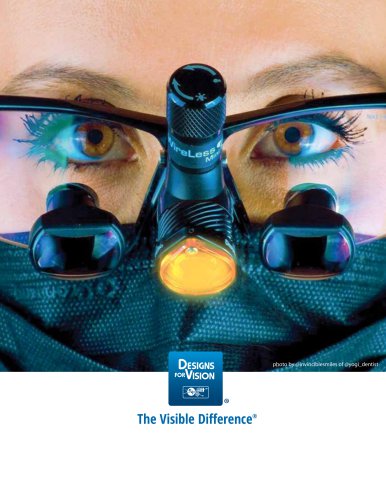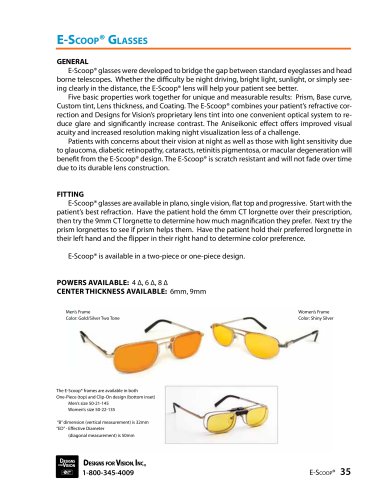 Website:
Designs for Vision
Website:
Designs for Vision
Catalog excerpts

There’s More to Optical Magnification than Meets the Eye Written by: Peter J. Murphy, B.S. Edited by: Marvin Hutt, Ph.D. A practical guide designed to provide the dental professional with sufficient optical information to select dental telescopes that will improve visual acuity AND aid in the prevention of eyestrain, neck and lower back pain.
Open the catalog to page 1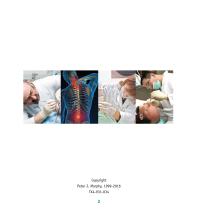
Copyright Peter J. Murphy, 1999-2016 TX4-931-034
Open the catalog to page 2
There’s More to Optical Magnification than Meets the Eye The use of magnification in dentistry can provide increased image size, which improves visual acuity and results in better patient care. However, magnification that simply increases image size is not enough. Only good magnification and illumination will help reduce eyestrain, neck and lower back pain. Good optical design is necessary to accomplish all objectives. This guide will provide you with enough information to decide what is best for the patient and you. In dentistry the most common occupational hazard is eyestrain. Studies...
Open the catalog to page 3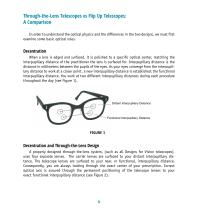
Through-the-Lens Telescopes vs Flip Up Telescopes: A Comparison In order to understand the optical physics and the differences in the two designs, we must first examine some basic optical rules. Decentration When a lens is edged and surfaced, it is polished to a specific optical center, matching the interpupillary distance of the practitioner the lens is surfaced for. Interpupillary distance is the distance in millimeters between the pupils of the eyes. As your eyes converge from the interpupillary distance to work at a closer point, a new interpupillary distance is established: the...
Open the catalog to page 4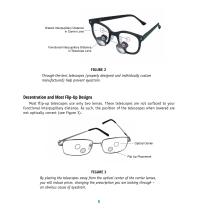
Distant Interpupillary Distance in Carrier Lens Functional Interpupillary Distance in Telescope Lens FIGURE 2 Through-the-lens telescopes (properly designed and individually custom manufactured) help prevent eyestrain. Decentration and Most Flip-Up Designs Most flip-up telescopes use only two lenses. These telescopes are not surfaced to your functional interpupillary distance. As such, the position of the telescopes when lowered are not optically correct (see Figure 3). Optical Center FIGURE 3 By placing the telescopes away from the optical center of the carrier lenses, you will induce...
Open the catalog to page 5
Working Distance, Depth of Field, Reflectance, and Field of View Working Distance There is no single, ideal working distance. Ideal working distances vary according to the individual.(7, 8, 9, 10, 11, 12) Thus, the ideal working distance built into a dental telescope should be exactly the proper ergonomic working distance for you. Any compromise in this automatically compromises your posture and may lead to eyestrain, neck and lower back pain. Sixty percent of dentists suffer lower back pain.(3) An examination of working distance easily demonstrates this: Working Distance Range Telescopes...
Open the catalog to page 6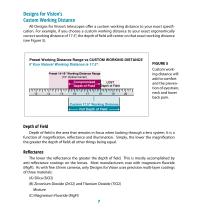
Designs for Vision's Custom Working Distance All Designs for Vision's telescopes offer a custom working distance to your exact specification. For example, if you choose a custom working distance to your exact ergonomically correct working distance of 17.5", the depth of field will center on that exact working distance (see Figure 5). FIGURE 5 Custom working distance will add to comfort and the prevention of eyestrain, neck and lower back pain. Preset Working Distance Range vs CUSTOM WORKING DISTANCE If Your Natural Working Distance Is 17.5": Custom17.5"WorkmgDistance < Full Depth °f Field >...
Open the catalog to page 7
Typical Magnesium Fluoride (MgFl) Coating TOTAL REFLECTANCE Designs for Vision’s Precision Multilayer Coatings provide FIGURE 6: Chemicals and independent testing by Melck (U.S.A.) and Kohno Optica (Japan) The coating is 7-layered and vacuum evaporated in the following order: (A) + (B) + (A) + (B) + (A) + (B) + (C) Evaporation time and temperatures used are ‘company confidential’ and not disclosed. The result of this precision multi-layered coating is a total reflectance curve sheet that is less than 0.5% and will withstand heat of 375°C (see Figure 6). The lower the reflectance, the better...
Open the catalog to page 8
A Keplerian system (e.g. Designs for Vision’s Expanded Field Telescopes) is always a positive objective lens with an erecting prism and a positive eye lens. It is a larger system, yet it permits a wider field of view and higher magnifications. Magnification: The higher the magnification the smaller the field of view. Distance of Eye Lens from the Eye: The closer the eye lens to the eye, the greater the field of view (stand away from a window, then move closer and note the increase in the field of view). Thus, given the same magnification, a through-the-lens telescope will always provide a...
Open the catalog to page 9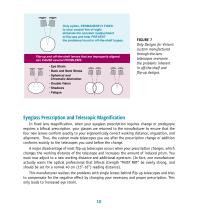
Only optics, PERMANENTLY FIXED to your coaxial line of sight, eliminate the constant readjustment of flip-ups and help PREVENT the problems found in off-the-shelf loupes. Flip-up and off-the-shelf lenses that are improperly aligned can CAUSE several PROBLEMS: • Eye Strain • Back and Neck Stress • Spherical and Chromatic Aberration • Double Vision • Shadows • Fatigue FIGURE 7 Only Designs for Vision’s custom manufactured through-the-lens telescopes overcome the problems inherent in off-the-shelf and flip-up designs. Eyeglass Prescription and Telescopic Magnification In fixed lens...
Open the catalog to page 10
Infection Control Fixed, Through-the-Lens Telescopes: These offer the safest method of infection control. The telescopes are disinfected with alcohol (Isopropyl Alcohol 70% by volume). They are positioned on your head. You then glove. The telescopes are left in place throughout the procedure. They are light enough and easy to see around if need be. At completion of the procedure, you remove and dispose the gloves. Lastly, place the telescopes on your chest for a face to face consultation with the patient without telescopes and mounting apparatus interfering. Flip-Up Telescopes: Cross...
Open the catalog to page 11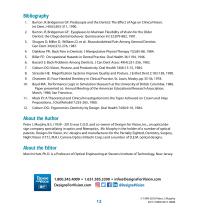
Burton JF, Bridgeman GF: Eyeglasses to Maintain Flexibility of Vision for the Older Dentist: the Otago dental lookover. Quintessence Int 22:879-882, 1991. Shugars D, Miller D, Williams D, et al: Musculoskeletal Pain Among General Dentists. Gen Dent 34(4):272-276, 1987. Diakkow PR: Back Pain in Dentists. J Manipulative Physiol Therapy 7(2):85-88, 1984. Biller FE: Occupational Hazards in Dental Practice. Oral Health 36:1194, 1946. Bassett S: Back Problems Among Dentists. J Can Dent Assoc 49(4):251-256, 1983. Coburn DG: Vision, Posture, and Productivity. Oral Health 74(8):13-15, 1984....
Open the catalog to page 12All Designs for Vision catalogs and technical brochures
-
LED DayLite®
4 Pages
-
Reveal
1 Pages
-
Infinity VUE TM
2 Pages
-
DENTAL MAGNIFICATION
8 Pages
-
E-Scoop® Glasses
1 Pages
-
LED DayLite Micro HDi
8 Pages
-
MicroSeries ScopesTM
8 Pages
-
Panoramic Loupes
4 Pages
-
LED Daylite series with HDi
4 Pages
-
ClearView Laser Telescopes
1 Pages
-
NanoCamHDi
2 Pages
-
Magnification
8 Pages
-
NikeLit
2 Pages
-
SurgLED
4 Pages




